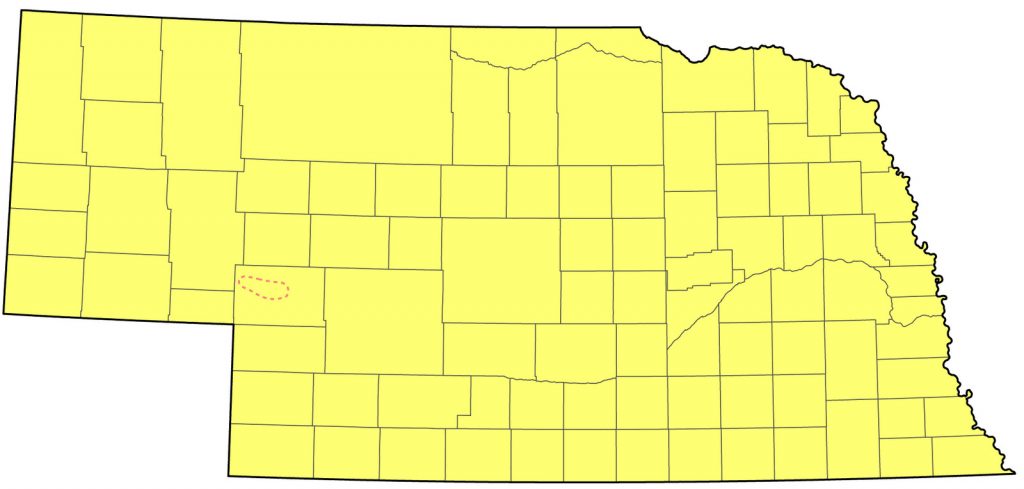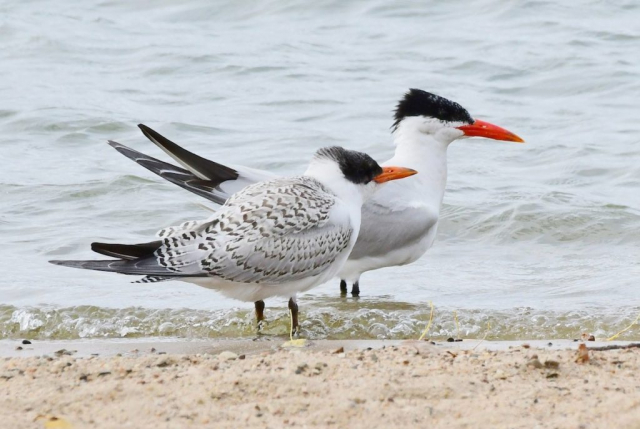Hydroprogne caspia
Status: Uncommon regular spring and fall migrant statewide. Uncommon regular summer visitor Lake McConaughy, rare casual elsewhere.

Documentation: Specimen: UNSM ZM14209, 5 May 1893 Salt Lake, Lancaster Co (Hudson 1934).
Taxonomy: No subspecies are recognized (AviList 2025).
Spring: Apr 20, 21, 22 <<<>>> Jun 13, 13, 14
There are earlier dates 9 Apr 2023 Ponca SP, Dixon Co, 14 Apr 2022 Scotts Bluff Co, 15 Apr 2022 Lancaster Co, 16 Apr 2016 Hall Co, and 16 Apr 2022 Douglas Co.
Later dates are discussed in Summer (below).
Caspian Tern is primarily a May migrant, mostly at large lakes and reservoirs. In recent years reports from the Panhandle have increased, possibly as a result of regional population increases (Wires and Cuthbert 2000).
- High counts: 35 at Branched Oak Lake, Lancaster Co 10 May 2025, 28 there 21 May 1997, 23 at Gavin’s Point Dam in Cedar Co 19 May 2021, and 20 at Branched Oak Lake 13 May 2012.
Summer: There are numerous mid-summer records, presumably of immatures; most do not breed until their fourth summer (Cuthbert and Wires 2020). One-year-olds generally remain on the wintering range, but sub-adults have the greatest tendency to wander (L’Arrivee and Blokpoel 1988; Cuthbert and Wires 2020).
Caspian Terns prefer large bodies of water and so most summer records are from Lake McConaughy, where the 49 records include high counts of 13 on 22 Jun 2023, 12 on 24 Jun 1996 (Brown et al 1996), and 11 on 29 Jul 2022.
There are 15 records away from Lake McConaughy 15 Jun-4 Jul, distributed statewide, six of these at Lancaster Co lakes.
Fall: Jul 5, 5, 6 <<<>>> Oct 1, 3, 3
Later dates are 6 Oct 2023 (2) Branched Oak Lake, Lancaster Co, 4-7 Oct 2024 Gavin’s Point Dam in Cedar Co, 24 Sep-8 Oct 2015 Lancaster Co, and 7 Nov 2003 Red Willow Co. The first report from the Panhandle occurred in Dawes Co 18 Jul 1990 (Grzybowski 1990), but since then there have been as many reports from the west as from the east.
Migration occurs from late Aug through most of Sep.
- High counts: 22 at LaPlatte Bottoms, Sarpy Co 8 Sep 2018, 17 at Branched Oak Lake 16 Sep 2013, and 14 there 6 Sep 2003.
Images
Abbreviations
NWR: National Wildlife Refuge
SP: State Park
UNSM: University of Nebraska State Museum
Literature Cited
AviList Core Team, 2025. AviList: The Global Avian Checklist, v2025. https://doi.org/10.2173/avilist.v2025.
Brown, C.R., M.B. Brown, P.A. Johnsgard, J. Kren, and W.C. Scharf. 1996. Birds of the Cedar Point Biological Station area, Keith and Garden Counties, Nebraska: Seasonal occurrence and breeding data. Transactions of the Nebraska Academy of Sciences 23: 91-108.
Cuthbert, F.J. and L.R. Wires. 2020. Caspian Tern (Hydroprogne caspia), version 1.0. In Birds of the World (S. M. Billerman, Editor). Cornell Lab of Ornithology, Ithaca, NY, USA. https://doi.org/10.2173/bow.caster1.01.
Grzybowski, J.A. 1990. Southern Great Plains Region. American Birds 44: 454-457.
Hudson, G.E. 1934. The first record specimen for Nebraska of the Caspian Tern. NBR 2: 37.
L’Arrivee, L., and H. Blokpoel. 1988. Seasonal Distribution and Site Fidelity in Great Lakes Caspian Terns. Waterbirds 11: 202-214.
Rosche, R.C. 1994. Birds of the Lake McConaughy area and the North Platte River valley, Nebraska. Published by the author, Chadron, Nebraska, USA.
Wires, L.R., and F.J. Cuthbert. 2000. Trends in Caspian tern numbers and distribution in North America: a review. Waterbirds 23: 388–404.
Recommended Citation
Silcock, W.R., and J.G. Jorgensen. 2025. Caspian Tern (Hydroprogne caspia). In Birds of Nebraska — Online. www.BirdsofNebraska.org
Birds of Nebraska – Online
Updated 23 Aug 2025

